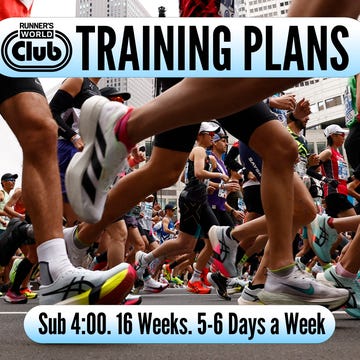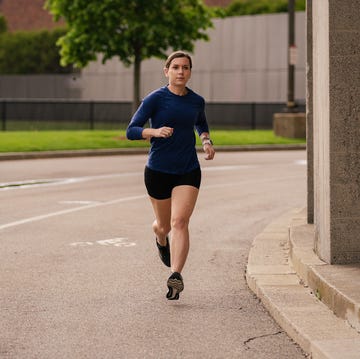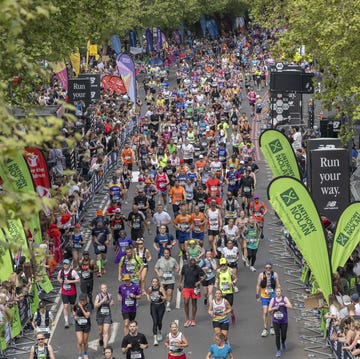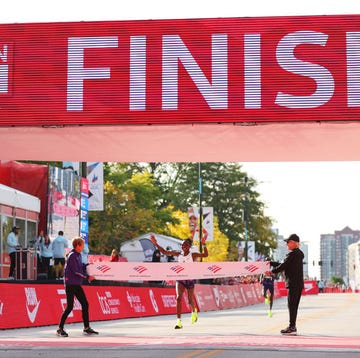We all know that interval training can improve various fitness markers, including VO2 max. But it’s not always easy to work out the exact impact of these improvements on your running. A new study suggests a simple solution: time trials. Why time trials? Because other measures are up-and-down. Training that boosts VO2 max, for instance, tends to diminish running economy, and vice-versa. These physiological measures don’t give you the full picture – for that, you need a time trial.
‘Time trials have a huge advantage when it comes to taking a sense check of how your training is going, either at the start of a block, midway through a block or indeed just as you approach race day,’ says Fiona English (@englishruns). ‘When I start coaching a new athlete, the very first session I will always get them to do is a 5K time trial. This both sets a mark in the sand against which we can look at the effectiveness of the training block we do, and sets guidance on the pace at which I would expect them to do their training runs and efforts.’
When it comes to the length of the time trial, English mostly uses 5K, both for its convenience and relevance to popular distances such as the marathon. As she explains: ‘For a lot of non-professional runners, [5K] is a great way to match race conditions, such as running this as a parkrun, and the time is more relatable to something like marathon training than shorter distances might be.’
What everyone's reading
However, if you’re focusing on speed and increasing pace, she recommends the one-mile time trial. ‘There is nothing quite as levelling, ugly, painful and yet beautiful as attempting to run a mile flat out,’ she says.
Ironically, the biggest benefit of a time trial – it’s ability to provide clear feedback on your current fitness – is also a potential pitfall. As English explains: ‘Time trials can give a huge boost of confidence that your training is having the desired effect, but if you perform poorly, that same effect can be a huge knock to your confidence.’
Time trials can also be problematic in that it can be hard to find the conditions that would emulate race day. ‘You often will be doing time trials fatigued, part way through a training plan and without the same focus on eating and resting that you might have in a normal racing week.’
The antidote to these potential pitfalls? Don’t see a time-trial as a be-all and end-all. Rather, use it as a rough assessment of your current fitness and training programme. Always ensure that your time trials are on the same course, ideally in similar conditions, and that you’re not too fatigued at the start. Finally, get creative. If, say, you’re looking to increase speed and typically use kilometres as your pacing metric, a one-mile time trial ‘won’t knock your confidence as much’, says English. Similarly, if you’re a mile merchant, ‘try a 1km time trial’.
A final note of caution: don’t just walk out your door and immediately begin your time trial with no preparation. ‘With all time trials, be careful to warm up properly and cool down properly, otherwise something short and sharp, particularly at the start of a training block or when you’ve got lots of fatigue from peak weeks, could increase your chance of a niggle,’ adds English.
Tips for effective benchmarking
Control variables: Perform benchmarks on the same route or track and ideally in similar conditions to avoid external influences on your performance.
Use technology: Use GPS technology or heart rate monitors to track metrics and analyse trends over time.
Be patient: Progress isn’t always linear. One off-day doesn’t negate weeks of solid training, so keep your benchmarks in perspective.
Recover well: Treat benchmarking workouts as key sessions. Prioritise recovery with proper nutrition, hydration and rest.
Non-running benchmarks: Don’t forget that progress in other areas such as recovery, strength and conditioning and nutrition can also be as critical as your running sessions.
Set realistic expectations: Benchmarks are tools for guidance, not perfect predictors of performance. Use them to give clues about your training, but look to wider measures such as general training and race results as well.
Key benchmark workouts for different goals
Courtesy of Tom Craggs, Runner’s World coach and road running manager for England Athletics.
1. General fitness and base building: 3-6-mile tempo run
Why?
For runners who are not focused on racing but want to build and maintain fitness, benchmarks should emphasise aerobic development and capacity. This develops your aerobic base while improving your ability to sustain effort.
How?
Warm up for 10-15 minutes, then run 3-6 miles at your comfortably hard pace (RPE 6-7/10, or around a pace that you could hold for 2:30-3 hours in a race). Finish with a 10-minute cooldown.
Progress check
Over time, aim to see less of an increase in heart rate and intensity during the run. If you are getting closer to a 5K or 10K race, aim to run three miles at a pace that you could hold for 60-65 minutes in a race and measure in the same way.
How often?
Every three weeks.
2. Anaerobic capacity: 600m time trial
Why?
Speed work isn’t just for middle-distance runners – it can be useful for all runners looking for rounded development to keep tracking. While there are more involved, and likely more accurate, ways to explore your top-end power, a 600m time trial is simple, easy to measure and isn’t so focused on pure power that long-distance athletes face injury risk or huge technical limits.
How?
Warm up really well, ensuring that it’s intense enough to make you feel ready to run at near maximal effort from the start. Then, time yourself over a 600m or roughly two-minute loop, running at maximal intensity for the distance. Cool down well.
Progress check
Record your splits and aim to maintain or even progress your pace while building your endurance with your longer sessions.
How often?
Every 3-4 weeks if you are training for races that are 5K or shorter.
3. 5K: 6 x 1km
Why?
Benchmarking for this race requires a mix of speed and endurance. This is a very 5K-specific session, but because it’s not continuous it allows it to remain manageable in both the early and later stages of a training plan.
How?
Warm up for 15-20 minutes with dynamic drills and strides. Run 6 sets of 1km at your best sustained effort, as close to your 5K race pace as possible, taking two minutes of rest in between. Cool down with 10-15 minutes of easy running.
Progress check
Monitor your splits – the session might not feel massively easier, but your pace should be dropping as you progress through your plan.
How often
Every 4-6 weeks.
4. 10K: 5-6 x 1 mile at goal race pace
Why?
The 10K is a test of both speed and endurance, requiring workouts that bridge shorter, intense efforts with sustained aerobic capacity. Mile repeats simulate the effort and pacing required for a strong 10K performance.
How?
After a 15-minute warm-up, run 5-6 x 1 mile at your goal 10K pace, with 90-120 seconds of easy jogging between repeats. Focus on even pacing across all intervals.
Progress check
Look for reduced heart rate or effort at the same pace, or faster times with consistent effort.
How often?
Every 3-4 weeks.
5. Half marathon: 4 x 10-minute cut down
Why?
For half marathoners, long intervals and tempo efforts are ideal for testing fitness and preparing for race day demands. This workout combines endurance with pacing practice, which are key components for the half marathon.
How?
Warm up for 15 minutes, then run 4 sets of 10 minutes with 90-second easy recoveries between each effort. Run the first set 5-10 seconds per mile slower than your goal race pace, sets two and three at your goal pace, then the fourth set 5-10 seconds per mile quicker than your goal pace.
Progress check
Monitor your ability to finish strong while maintaining form and focus. Improved pacing control is a sign of fitness gains.
How often?
Every 3-4 weeks.
6. Marathon: 3-5 x 5K at goal marathon pace
Why?
The marathon is a test of endurance and mental toughness, so benchmarks should reflect these. It also has benchmarking challenges, as unlike the 5K or 10K you can’t benchmark at or near your full race volume without overcooking your training. As such, these sessions are fatiguing and you’ll need to be careful with what you monitor to know what things are progressing. Running at marathon pace trains your body to handle the physical and mental demands of race day.
How?
Warm up for 15 minutes, then run 3-5 x 5km (or 20 minutes) at your goal marathon pace, with two minutes of easy between efforts. Focus on maintaining a steady effort and even splits. Cool down with 10-15 minutes of easy jogging.
Progress check
Despite this being a very challenging workout, it’s still only 15-25km at a pace that you hope to run for 42km. There’s a big difference between hitting your paces but clinging on by the end of the session and hitting your paces while seeing very little increase in perceived effort, heart rate, core temperature and intensity – that’s what you’re looking to measure.
How often?
Every 4-6 weeks.













